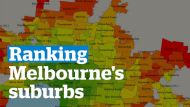In a first-world city such as Melbourne, the difference between the best and the worst suburb is not that extreme.
But when that city is deemed the most liveable in the world, it begs the question: where is the most liveable neighbourhood?
More News Videos
Ranking Melbourne's suburbs
Rankings are a highly subjective process, and researchers stress this Melbourne liveability study is about the quality of suburbs and not about the people who live in them.
After Melbourne won the title in an Economist magazine survey a decade ago, Deloitte Access Economics and Tract Consultants teamed with The Age to answer this question.
Now in its third edition, the Liveable Melbourne study has 15 indicators ranking Melbourne's suburbs: proximity to the coast; closeness to the CBD; train and tram and bus services (each mode was weighted for their importance; trains are worth the most, followed by trams then buses); road congestion; culture; education; shopping; public open space; tree cover; topographic variation; cafes and restaurants; and crime.

Each indicator was chosen based on what was understood to be important to Melburnians, and the authors concede some – such as topographic variation (hills) especially – are contentious. But, once chosen, the results of the survey were based on what the data revealed, not on opinion.
The number of schools was measured, but not their quality. Violent crimes were grouped in with other criminal activity. Affordability was not included because that would dilute the very trend the researchers were trying to highlight – more expensive real estate tends to be found in more liveable places.
For the 2015 survey, an incredibly sophisticated quantity and quality of data was available, from agencies including the Bureau of Statistics, Public Transport Victoria, the Victorian planning department, VicRoads, Crime Statistics Agency Victoria and the federal communications department.
The Liveable Melbourne survey excluded a number of suburbs, include those less than five years old on the fringes, either because of a lack of data, or because it would be considered unfair to compare them to established areas. It also excluded suburbs with a high percentage of holiday homes – the Mornington Peninsula in particular. And suburbs with fewer than 200 people were left out.
Once these exclusions were made, each of the remaining 321 suburbs were given a relative ranking – based on each indicator being given a score from zero to five based on reliable data ranging from the ABS, VicRoads, local government and others.









